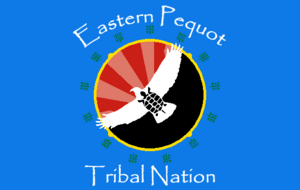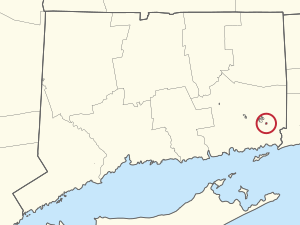Eastern Pequot Tribal Nation facts for kids
 |
|
| Total population | |
|---|---|
| Enrolled members: 1,150 (2003) | |
| Regions with significant populations | |
| Languages | |
| English, formerly Pequot | |
| Religion | |
| Christianity | |
| Related ethnic groups | |
| Mashantucket Pequot |
The Eastern Pequot Tribal Nation is a Native American tribe. They live in southeastern Connecticut. Their ancestors were the Pequot people. The Pequots were a very powerful group in New England in the 1600s. The Eastern Pequot Tribal Nation is one of five tribes that the state of Connecticut officially recognizes.
In 2002, the United States government officially recognized the Eastern Pequot Tribal Nation. This happened after two groups, the Eastern Pequot and the Paucatuck Eastern Pequot, decided to join together. They had both asked for federal recognition separately. However, in 2005, the government changed its mind and took away their recognition. This was a rare event, as the government had not done this to a tribe since the 1970s. In 2012, the Eastern Pequot Tribal Nation went to court. They wanted to get their federal recognition back.
Contents
History of the Pequot People
The Pequot people living today are descendants of a strong tribe. This tribe was very powerful in southeastern New England during the 1600s. Their power greatly decreased after the Pequot War in 1637. Many Pequots who survived the war were placed under the care of other tribes. Some went to the Mohegan tribe in the west. Others went to the Narragansett people in the east.
In 1654, the colonial government moved some Pequots. These Pequots were no longer under the care of the Eastern Niantic leader, Ninigret. The Bureau of Indian Affairs (BIA) said in 2002 that these Pequots were then led by two Native American rulers. Their names were Harmon Garrett and Momoho.
Lantern Hill Reservation
In 1683, the Colony of Connecticut bought land for Momoho's Pequots. This land was at Lantern Hill. Since then, this tribe has always been recognized by the state. They have also had a reservation.
The Eastern Pequots are descendants of those Pequots who escaped. They returned from the Narragansetts to their original lands. In 1683, the colonial government gave them a reservation. This land was on Lantern Hill in North Stonington, Connecticut. Today, this reservation is about 224 acres.
Other Pequots returned from Mohegan supervision in the west. They were led by Harmon Garrett. The colony gave them a reservation near Ledyard, Connecticut. These Pequots became known as the Western Pequots. They are also called the Mashantucket Pequots.
Over hundreds of years, both groups married people from other backgrounds. But they kept their culture alive. They continued their traditional crafts and customs. By the 1900s, many descendants had mixed backgrounds. Still, some identified themselves as Pequot.
In the 1930s, the tribe started to have disagreements. These were about who was a true member. This was made worse by competition for resources. There was also limited space on the Eastern Pequot Reservation.
Seeking Federal Recognition
The Eastern Pequots began trying to get federal recognition in 1979. Federal recognition means the U.S. government officially recognizes them as a tribe. In 1990, about 150 members started a separate request. They wanted recognition as the Paucatuck Eastern Pequot tribe. However, most members of both groups continued to live on the 224-acre reservation.
Meeting Federal Rules
The Eastern Pequots believed they met the government's requirements. They said:
- They had always been known as an Indian tribe in their community.
- They had always been a separate community.
- They had leaders who had power over their members.
- Current members were descendants of a historical Indian tribe.
- Most members lived on or near the reservation and had family ties.
In 1998, the Bureau of Indian Affairs (BIA) looked at both requests together. Ronald Wolf Jackson, the Eastern Pequot treasurer, said the differences were just a "leadership dispute." He believed a fair review would show they were one tribe. Some people supporting the Paucatuck group thought the Eastern Pequot wanted a casino. However, both groups said they were not interested in a casino.
Recognition and Reversal
In March 2000, the BIA suggested recognizing both tribes. During their final review, the BIA encouraged the two groups to unite. They noted that history showed they were one tribe. They had common ancestors and a shared history on the reservation. In June 2002, the Secretary of the Interior officially recognized the Eastern Pequot Tribal Nation.
The Attorney General of Connecticut, Richard Blumenthal, appealed this decision. He was worried the tribe would build a third casino in the state. Connecticut officials argued that the BIA had made a mistake.
In 2005, the BIA took away their recognition. This happened after another internal review. They had also taken away recognition from the Schaghticoke Tribal Nation in Connecticut in 2004. In January 2012, the Eastern Pequots filed a lawsuit. They wanted the BIA's recognition to be put back. State and local leaders had opposed recognition. They were concerned about a large casino and its effects on local communities. The Eastern Pequot's reservation is near the Foxwoods Resort. This casino is run by the Mashantucket Pequot tribe.
In 2015, the BIA made new rules. These rules state that tribes cannot ask for federal recognition again if they have already been denied. The tribe has not tried to get recognition through the United States Congress. This is because many people in the Northeast do not like gambling. This would make it hard to get approval.
Eastern Pequots and Donald Trump
On May 28, 2003, Donald Trump filed a lawsuit against the reunited tribes. He claimed he was left out of their development plans. When the tribes were separate, he had made a deal with the smaller Pawcatuck Eastern Pequot group. But the reunited tribe chose a different company to work with.


